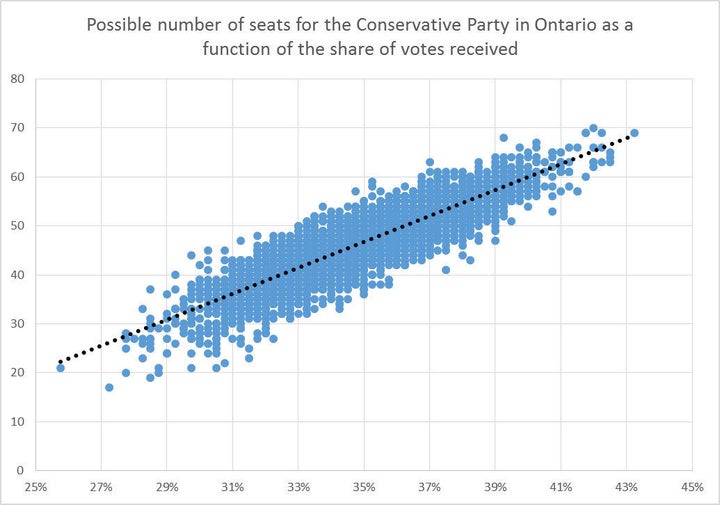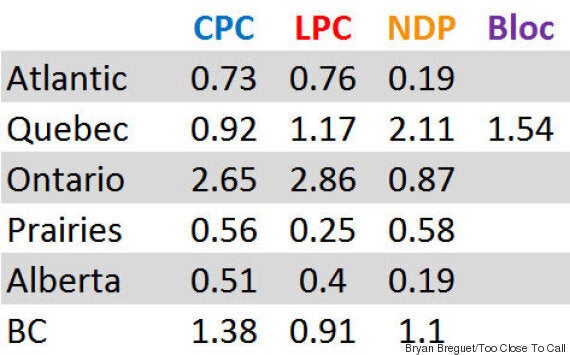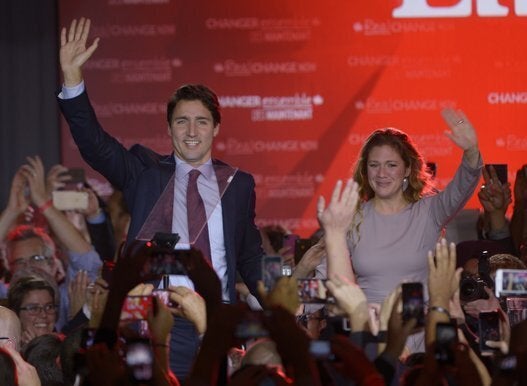With less than a week to go, this election is turning into a race between the Conservatives and Liberals. But projections are only as good as the polls they are based on.
If the numbers on election night turn out to be different from the voting intentions indicated by the polls, our projections will obviously be off. There is really no way around it.
With that said, the effect of an over- or underestimation in the polls varies from one party to the next, and one province to another.
It doesn't matter much, for instance, whether the Conservatives are at 50 or 55 per cent in Alberta — they'll win the most seats easily in either case — but the same error in Ontario could make the difference between who finishes first in the whole election. Many factors are in play, including the size of the province and how competitive the race is.
Fortunately for us, we do account for the possibility of polls' being wrong, including mistakes as big as what happened in Alberta in 2012 or British Columbia in 2013. We do this by using simulations.
Specifically, when the polls show one party at, say, 35 per cent in a province, we acknowledge that it could actually be as high as 40 per cent or as low as 30.
The graph below represents all the possible outcomes for the Conservatives in Ontario. The horizontal variation is there to account for the uncertainty of the polls (what people refer to as the margin of error, even though we actually go beyond that because we believe the level of uncertainty to be much higher) while the vertical variations show the effects of vote efficiency (i.e: the transposition from votes into seats, which isn't perfect with our electoral system).
We added a trend to make the average relationship more visible.

The Conservatives are currently projected at 34 per cent and 46 seats in Ontario. But you can see that a slight mistake by the polls could result in a significantly different seat count.
We decided to estimate the effect of a one-point error on the number of seats projected for one party in each province. The higher the number, the bigger the impact polling mistakes will have on our projections. Alternatively, you can interpret these numbers as where the parties can currently win or lose seats if they increase or decrease by a couple of points in voting intentions. The table below shows the results for each party in each province.

As mentioned before, polls can be wrong in Alberta without causing major mistakes. Specifically, a one-point overestimation of the Tories (i.e: polls show them at 50 percent but they'd only receive 49 per cent on Monday) would cost the party only 0.5 seat in average.
On the other hand, the same error in Ontario could put our projections off by up to six seats. Indeed, imagine the Liberals to be underestimated by one point and the Conservatives to be overestimated by the same amount. In such a case, the Liberals would win 2.86 more seats and the Tories 2.65 fewer. Rounding and summing, it's a total difference of six seats, more than half of the current Conservative lead in our overall projections.
These numbers show once again why Ontario is the battleground for Stephen Harper and Justin Trudeau and where the winner will most likely be chosen. As we have previously shown, the Liberals really need to win Ontario by a good eight to 10 points if they want to have first crack at forming the next government. Polls do seem to indicate they are getting close to that, although the polls clearly don't all agree.
Quebec is interesting because the four main parties are all above 20 per cent. The New Democrats, however, are still slightly ahead and benefit from the first-past-the-post electoral system and the concentration of Liberals and Conservatives votes in specific regions. But every point lost, especially to the Bloc, is quite costly to the NDP. Looking at this table, we expect Thomas Mulcair to spend most of the last week in Quebec and British Columbia.
To go back to the notion of polling mistakes, our projections will be fine as long as pollsters don't over- or underestimate the Liberals and Tories in Ontario. If they get that right, we should be able to accurately project the outcome of the election.
Pollsters also need to get the NDP-Bloc gap right in Quebec and, to a lesser extent, the level of support for the Tories in B.C. Everywhere else, we can afford to have polls be off, even significantly.
As a reminder, though, the polling companies were especially wrong in 2011 in Ontario.
Let's hope this doesn't happen again on Monday, or we could have surprises.
ALSO ON HUFFPOST:

Bryan Breguet has a B.Sc in economics of politics and a M.Sc in economics from the University of Montreal. He founded TooCloseToCall.ca in 2010 where he provides electoral analysis and projections. He has collaborated with the National Post, Journal de Montreal and l'Actualité.
He will provide analysis and updates for The Huffington Post Canada throughout the federal election campaign. For riding by riding projections, visit his interactive simulator.
